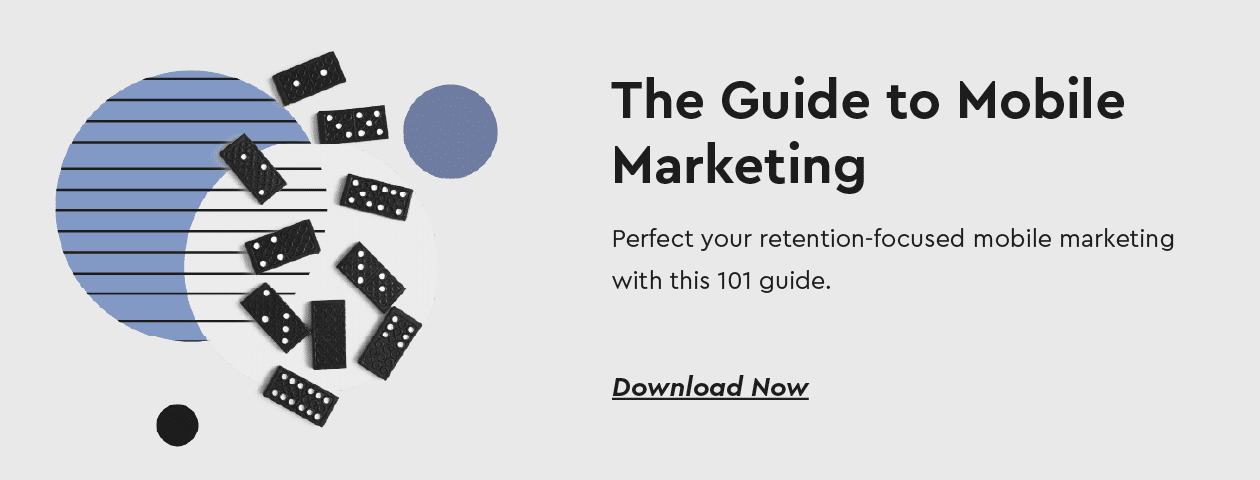What is Location-Based Marketing?
Location-based marketing uses customer location data from mobile devices to send messages to customers about a nearby business. Using a customer’s location, you can send highly personalized messages based on the context of a customer. For example, when a customer is close to your store, you can send messages to them about offers to encourage them to visit said store. In short, location-based marketing connects the digital world of mobile devices to the customer’s physical location.
You do not have to use location-based marketing to only target customers near your store. For example, when a customer is in a place where they usually spend a lot of time on their phones or near competitors’ locations. Location-based marketing connects brands with customers who have visited or are visiting their store or another specific location that will drive traffic to the brand.
Download Now: All you need to know about mobile marketing
Types of Location-Based Marketing
Location-based marketing uses customers’ locations to customize marketing strategies. It is most effective when you choose locations that will reach many customers, and those customers are likely to engage with your business after receiving messages. Here are some examples of location-based marketing methods:
- Geotargeting – uses the IP addresses of customers’ mobile devices to determine their location and send messages based on proximity to a store, competitors, and more.
- Geofencing – set a pre-determined boundary using GPS technology. When customers enter or exit the perimeter, they will receive marketing campaigns.
- Beaconing – devices use WIFI or Bluetooth to target customers within a small area. The beacon sends a signal to the mobile device when a customer enters the range. Then the customer receives content on the mobile device.
- Geo-Conquesting – sets a boundary around competitors’ locations and uses GPS technology to track when customers enter the boundary. When customers enter the area around competitors, they will receive messages discouraging them from shopping at competitors’ locations.
Brands can send location-based marketing campaigns through in-app messages, mobile push notifications, and even SMS. When a user allows your app to track their location, you can send them said messages encouraging them to visit the store, take action, or complete a transaction.

The Benefits and Disadvantages of Location-Based Marketing
Location-based marketing has many benefits for your brand as you can send relevant and personalized content to customers based on their location. Most people have mobile devices and take them everywhere, making location-based marketing an effective way to target customers. Benefits of location-based marketing include:
- Increase in Traffic – sending messages about offers and promotions to customers near your store encourages them to visit your store, increasing foot traffic.
- Relevancy – location-based marketing uses real-time data about customers’ locations, so ads are personalized and effective by leveraging good timing and messaging.
- User Experience – sending users more relevant information gives them a better user experience and shows that you understand the customers’ preferences.
- Data Collection – collecting location data from previous campaigns can help you understand customer behavior to help you optimize future campaigns.
Although location-based marketing has many benefits, customers have privacy concerns, and customers must permit brands to use their location. Some disadvantages of using location-based marketing include:
- Users Must Opt-In –: location-based marketing only works when users allow apps to collect and use the location technology. Not all customers opt-in for privacy reasons; if they do not opt in, you cannot use location-based marketing to target that customer.
- Non-Smartphone Users – you cannot use location-based marketing on people who do not own smartphones, so a large segment of customers cannot be targeted by these messages.
- Irrelevant Content – works well when you segment customers well and target the segments correctly. Avoid sending messages to a large audience in a specific location and only send relevant information to users by understanding customer behavior and segmenting customers strategically.
- Location Data – the location data must be accurate for location-based marketing to work. If your location data is inaccurate or ineffective, you will target customers with irrelevant content.
- Getting Customers’ Attention – customers receive many notifications, and it can be hard to ensure customers see your campaigns. Send users personalized content, so they have a reason to continue getting notifications from you and avoid sending users too much content.
The Guide to Mobile Marketing
Perfect your retention-focused mobile marketing with this 101 guide.
How Effective is Location-Based Marketing?
Many people have smartphones and carry their phones with them everywhere they go. Therefore, there are many opportunities to collect and analyze customer location data and send personalized messages based on a customer’s location. Location-based marketing effectively gets information about your business, boosts in-store traffic, and increases brand awareness. It is also a relatively cost-effect marketing strategy that is highly effective if done correctly.
How to use Location-Based Marketing in Emails
Customers’ location can also be leveraged to provide contextual personalization in emails. Using geo-targeting in emails allows marketers to dynamically adapt their emails based on a customer’s physical location increasing the message’s relevancy and engagement. Some examples of location-based marketing in emails include:
- Geo-Targeted Images – dynamically change the displayed image based on the customer’s location, adding another layer of personalization and relevance to your emails. Segmenting offers based on location, personalizing prices and currencies, and segmenting product recommendations are examples of this.
- Map Navigation – automatically generate a map for a specific pre-defined location or for the nearest store, customized per recipient, powered by Google or Bing maps. Using map navigations are great for in-person events and offers with a goal of driving store foot traffic.
- Weather information – show recipients the upcoming weather in a specific/fixed location anywhere in the world. Geo-location-based weather is a great way to provide customers with additional information about an event they will be attending or personalizing emails for travel customers based on their current whereabouts.
Frequently Asked Questions
What is location-based SEO?
Location-based SEO focuses on helping websites rank higher in search engine results for location-specific searches. The goal is to increase visibility and attract customers to local businesses. This tactic typically involves targeting keywords with geographic modifiers (e.g., “restaurants in New York City”).
What type of businesses use location-based marketing?
Great question!
Many types of businesses utilize location-based marketing.
First, retail stores and restaurants take advantage of this tactic to target customers that are close in proximity to their business. They can send real-time offers and promotions to encourage customers to walk inside.
Similarly, hotels and tourist attractions employ location-based marketing to send out local tourist recommendations, or personalized messages to guests based on their proximity to the hotel and their travel preferences.
Next, mobile apps such as food delivery services, fitness apps, or navigation apps, use location-based marketing to enhance user experiences. For example, they can provide location-specific recommendations or targeted advertisements based on the user’s current location.
Finally, event organizers can use location-based marketing to promote events such as concerts, conferences, and trade shows to potential attendees in the local area.
These are just a few examples. Location-based marketing can be used many other industries as well. The key is to leverage location data to deliver personalized messages to individuals within a specific proximity.

How Optimove Uses Location-Based Marketing
Optimove’s geofencing and beacon technology helps brands send effective location-based marketing campaigns. With Optimove, create strategic customer segments to target customers with highly relevant content based on their location.
Contact us today or request a Web demo to learn how you can use Optimove to send personalized messaging with location-based marketing campaigns.
Get a personalized tour of Optimove
Let us show you how to go from tens to hundreds of segments
